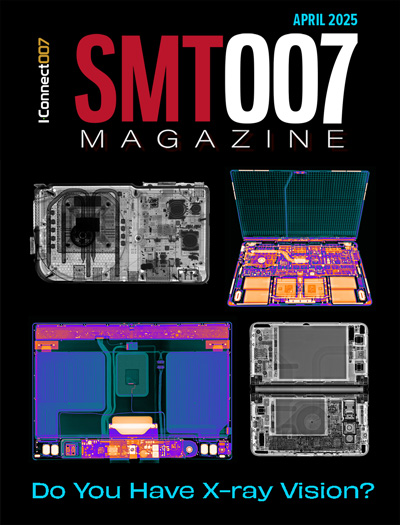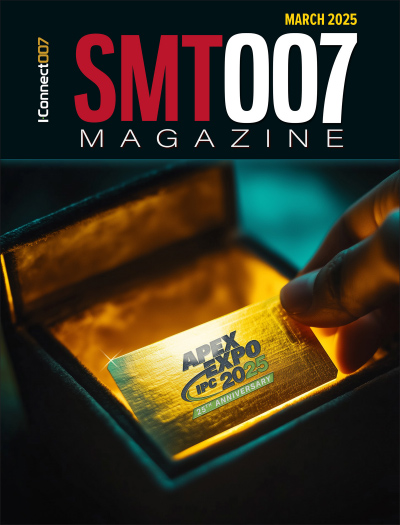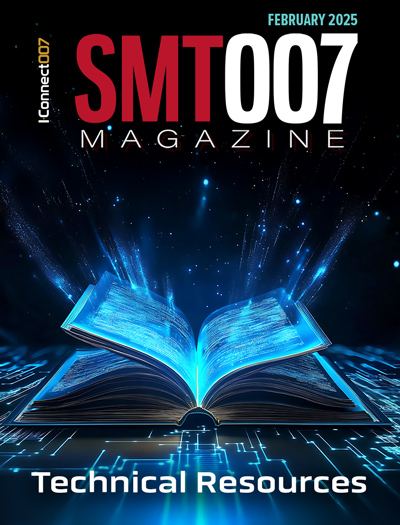-

- News
- Books
Featured Books
- smt007 Magazine
Latest Issues
Current Issue
Do You Have X-ray Vision?
Has X-ray’s time finally come in electronics manufacturing? Join us in this issue of SMT007 Magazine, where we answer this question and others to bring more efficiency to your bottom line.

IPC APEX EXPO 2025: A Preview
It’s that time again. If you’re going to Anaheim for IPC APEX EXPO 2025, we’ll see you there. In the meantime, consider this issue of SMT007 Magazine to be your golden ticket to planning the show.

Technical Resources
Key industry organizations–all with knowledge sharing as a part of their mission–share their technical repositories in this issue of SMT007 Magazine. Where can you find information critical to your work? Odds are, right here.
- Articles
- Columns
Search Console
- Links
- Media kit
||| MENU - smt007 Magazine
Estimated reading time: 4 minutes
Flex Talk: Mina—Trouble-Free Soldering to Aluminum
I always love to hear about interesting new IoT applications. The other day, a friend was explaining a new product he had recently developed, a home-built RFID-based tracking algorithm used to help improve and change how conferences and events are done around the world. Essentially, this tracking system—enabled by RFID tags and card readers—allows event organizers to analyze attendees’ preferences and interests and create personalized recommendations on topics, somewhat like a Netflix recommendation engine. Thinking about the RFID market and the significant growth projected in this market, I decided to do a little research on RFID tag manufacturing. During this research, I learned of a relatively new offering, Mina, an advanced surface treatment technology that addresses the common constraints of large scale manufacturing of Al-PET circuits.
Aluminum on polyester (Al-PET) circuits are becoming more popular and have found wide use in RFID tag and single-layer circuits to reduce cost. However, both aluminum and PET have their own constraints and require special processing to make finished circuits. Aluminum is not easy to solder to at lower temperatures and PET cannot withstand high temperatures. Conventional low-temperature solder cannot be used to attach components to these circuits without additional processing or using conductive epoxies. These add costs, which limit the use of Al-PET circuits. Initially developed to help a customer with a manufacturing cost issue, Averatek has recently developed Mina, which can be applied to the antenna as it is being manufactured on high-speed roll-to-roll lines. The antenna can then be sent to customers who assemble the die and then on to the tag makers. This relatively new surface treatment paves the way for large scale, low cost manufacturing of Al-PET circuits.
Conventional Methods to Assemble RFIDs
Assembly of RFID tags involves mounting of chips onto the pads of the circuit. Although the use of solder is preferred, soldering to aluminum is difficult because of the presence of a thin layer of aluminum oxide. This layer forms when the bare metal is exposed to air. Since the manufacturing of Al-PET substrates is done in atmospheric conditions, all aluminum surfaces are covered with aluminum oxide. While the formation of oxide is self-limiting, its presence prevents the bonding of solder to the base aluminum.
Special processing can be done on pads to remove and prevent the formation of aluminum oxide. These include ENIG, nickel-palladium or nickel-silver plating. These need a series of process steps and extensive wet chemistry, which add costs that make it prohibitive for mass production.
Anisotropic conductive paste (ACP) is a common solution to this problem and is widely used for attaching components to aluminum based RFIDs. It is applied on the face of the chip, which is then attached to the antenna using heat and pressure. However, ACP has its own challenges. It is made of adhesive epoxy filled with conductive metal particles, usually silver. These are typically syringe applied, require longer cure times, have pot-life issues and are electrically inferior to conventional solders. In addition, they must be stored at low temperatures in special freezers to control the polymerization of the epoxy.
Assembly of RFIDs with Mina
Evaluations began last November for Mina. This surface treatment can be printed directly on the aluminum pads where components need to be assembled. Any of the conventional printing techniques can be used including screen, stencil, etc. The aluminum surface does not need any surface cleaning or preparation. Once printed, it is then thermally cured and leaves the pad surface active and ready to accept solder. Cured Mina is non-conductive and makes room for easy printing registration. To attach a component, it simply would need solder on it via plated bumps or printing, placed on a Mina activated pad, and then passed through a re-flow oven. Mina removes the aluminum oxide layer and allows the formation of a true metal-to-metal bond between the solder and the aluminum on the pads. Both the electrical properties and the bond strength are better than ACP. In addition, Mina can be stored at room temperature and reused multiple times.
Figure 1: Production and assembly process using Mina.
Figure 2: Graphic of Mina application.
Benefits of Mina
- Screen-printed on pads leaving an active, but non-conductive surface
- Cost-effective as it allows the use of conventional solder and only on pads
- Mina can be applied to the pads and cured in a conventional, low-temperature oven
- Solder can be plated or printed on the chip using conventional methods and then reflowed onto the active pads
- Enables solder to bond directly to aluminum metal, ensuring good electrical properties
- Has no pot-life issues; Mina can be printed, stored and re-used at room temperature
Given the significant growth projected for the RFID tag market in the next several years, it will be interesting to see how this relatively new advanced surface treatment is adopted into mass production and to see what other markets benefit from enabling the ease of soldering to aluminum.
Tara Dunn is the president of Omni PCB, a manufacturer’s rep firm specializing in the printed circuit board industry. To read past columns or to contact Dunn, click here.
More Columns from PCB Talk
PCB Talk: Is DWM Just Another Buzzword?PCB Talk: Burning Questions About Designing for SAP
PCB Talk: SAP—Changing the Way You Look at PCB Design
PCB Talk: SAP Evaluating From Design Perspective
PCB Talk: Creative Minds Pushing Boundaries
PCB Talk: Additive Electronics—Are You One of the Curious?
PCB Talk: Collaboration To Shorten the Learning Curve
PCB Talk: A Review of Additive Electronics


